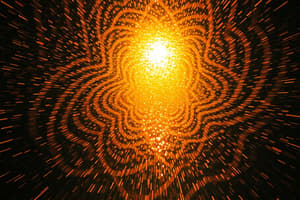Podcast
Questions and Answers
What unit is used to measure illuminance?
What unit is used to measure illuminance?
- Candelas
- Lux (correct)
- Lumens
- Watts
The angle of incidence is always equal to the angle of refraction.
The angle of incidence is always equal to the angle of refraction.
False (B)
What is the term for the wave that strikes the boundary?
What is the term for the wave that strikes the boundary?
incident wave
The result of the superposition of two or more waves is called __________.
The result of the superposition of two or more waves is called __________.
Match the following terms with their definitions:
Match the following terms with their definitions:
What is the term used to describe the bending of light as it passes the edges of a barrier?
What is the term used to describe the bending of light as it passes the edges of a barrier?
The primary colors of light are red, green, and blue.
The primary colors of light are red, green, and blue.
What causes white light to split into a spectrum when it passes through a prism?
What causes white light to split into a spectrum when it passes through a prism?
A pigment that absorbs two primary colors and reflects one color is called a __________ pigment.
A pigment that absorbs two primary colors and reflects one color is called a __________ pigment.
Match the following colors with their classification:
Match the following colors with their classification:
Which process describes producing light with a specific pattern of oscillation?
Which process describes producing light with a specific pattern of oscillation?
Complementary colors are two colors that combine to absorb all wavelengths of visible light.
Complementary colors are two colors that combine to absorb all wavelengths of visible light.
Light falls within the range of wavelengths from about __________ nm to __________ nm.
Light falls within the range of wavelengths from about __________ nm to __________ nm.
What type of light is produced when the electric field of a light wave oscillates in random directions?
What type of light is produced when the electric field of a light wave oscillates in random directions?
The human voice is produced by the vibration of vocal cords located in the lungs.
The human voice is produced by the vibration of vocal cords located in the lungs.
What is the term for a resonating tube with one end closed to air?
What is the term for a resonating tube with one end closed to air?
A medium that does not transmit light and reflects and absorbs it is called ______.
A medium that does not transmit light and reflects and absorbs it is called ______.
Match the following types of mediums with their characteristics:
Match the following types of mediums with their characteristics:
Which of the following describes a medium that allows objects to be seen clearly through it?
Which of the following describes a medium that allows objects to be seen clearly through it?
The unit of luminous flux is the lumen.
The unit of luminous flux is the lumen.
What is the effect of the length of the air column on the frequencies of vibrating air?
What is the effect of the length of the air column on the frequencies of vibrating air?
Flashcards
Illuminance
Illuminance
The amount of light falling on a given surface area at any given time.
Lux (lx)
Lux (lx)
The unit of measurement for illuminance. Equivalent to lumens per square meter.
Principle of Superposition
Principle of Superposition
The principle that the displacement of a medium caused by multiple waves is the sum of the displacements caused by each individual wave.
Standing Wave
Standing Wave
Signup and view all the flashcards
Law of Reflection
Law of Reflection
Signup and view all the flashcards
Precision
Precision
Signup and view all the flashcards
Nonpolarized Light
Nonpolarized Light
Signup and view all the flashcards
Luminous Sources
Luminous Sources
Signup and view all the flashcards
Illuminated Sources
Illuminated Sources
Signup and view all the flashcards
Transparent Medium
Transparent Medium
Signup and view all the flashcards
Translucent Medium
Translucent Medium
Signup and view all the flashcards
Opaque Medium
Opaque Medium
Signup and view all the flashcards
Luminous Flux
Luminous Flux
Signup and view all the flashcards
Diffraction
Diffraction
Signup and view all the flashcards
Wavelength of Light
Wavelength of Light
Signup and view all the flashcards
Dispersion of Light
Dispersion of Light
Signup and view all the flashcards
Primary Colors (Additive)
Primary Colors (Additive)
Signup and view all the flashcards
Secondary Colors (Additive)
Secondary Colors (Additive)
Signup and view all the flashcards
Complementary Colors
Complementary Colors
Signup and view all the flashcards
Color and Reflection
Color and Reflection
Signup and view all the flashcards
Polarization
Polarization
Signup and view all the flashcards
Study Notes
Light and Optics
- Diffraction: The bending of light as it passes the edges of a barrier
- Huygen's Wavelets: Combine to form a straight wavefront, except at the edges where they spread out in a circular manner when a barrier creates an edge.
- Light Splitting: A narrow beam of sunlight or white light passing through a glass prism splits into different colors.
- Refraction: White light crossing from air to glass and back to air causes each color to bend at different angles.
- Spectrum: Unequal bending of colors spreads white light into a spectrum.
- Wavelength: Light has wave properties, each color associated with a specific wavelength.
- Visible Light Wavelength Range: Approximately 400 nm to 700 nm.
- Additive Color Process: White light can be formed by adding red, green, and blue light in equal amounts. Red, green, and blue are primary colors.
- Primary Colors: Red, green, and blue.
- Secondary Colors: Yellow, cyan, and magenta (combinations of two primary colors).
- Complementary Colors: Two colors of light that combine to make white light.
- Object Color: Depends on wavelengths present in illuminating light and wavelengths absorbed or reflected by the object's dyes or pigments.
- Primary Pigments: Absorb one primary color and reflect two from white light.
- Secondary Pigments: Absorb two primary colors and reflect one.
- Polarization: Production of light with a specific oscillation pattern. Nonpolarized light has random oscillation directions of the electric field.
- Sound Production: Produced by vibrations of a vibrating object, creating particle motions and pressure oscillations in the air.
- Human Voice Production: Vibrations of the vocal cords, air from lungs starts the vibrations.
- Resonating Tubes (Closed and Open Pipes): Closed-pipe resonators have one closed end, while open-pipe resonators have both ends open. Sound waves reflect differently in each type of pipe.
- Ray Model of Light: Light is represented as a ray traveling in a straight path, direction changed only by obstruction.
- Luminous Sources: Emit their own light (e.g., the sun).
- Illuminated Sources: Reflect light from other sources (e.g., the moon).
- Opaque Media: Do not transmit light, absorb and reflect light (e.g., brick). Transparent Media: Transmit most light (e.g., air, glass).
- Translucent Media: Transmit and reflect light but do not allow objects to be clearly seen through them (e.g., frosted glass).
- Brighter Sources: Produce more light rays than less bright sources.
- Luminous Flux (P): Rate at which light energy is emitted from a luminous source. Unit: Lumen (lm).
- Illuminance (E): Luminous flux falling on a given surface area. Unit: Lux (lx) = lumens per square meter (lm/m²).
- Point Source: Light rays spread out from a point in all directions. The number of light rays illuminating a unit of area decreases as the square of the distance from the point source.
- Light Intensity Units: Candelas (cd) - measure of luminous intensity not flux.
- Incident Wave: Wave that strikes a boundary
- Reflected Wave: Returning wave after reflection.
- Principle of Superposition: Displacement of a medium caused by multiple waves is the algebraic sum of individual displacements.
- Interference: Result of superposition of two or more waves, where waves can appear to stand still (standing waves).
- Reflection: Angle of incidence equals angle of reflection.
- Shallow/Deep Water Wave Effect: Frequency remains the same, but wavelength changes due to velocity change.
Studying That Suits You
Use AI to generate personalized quizzes and flashcards to suit your learning preferences.




